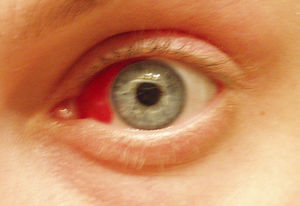Subconjunctival hemorrhage: Difference between revisions
Ostermayer (talk | contribs) (Text replacement - "Category:Ophtho" to "Category:Ophthalmology") |
Neil.m.young (talk | contribs) (Text replacement - " pt " to " patient ") |
||
| Line 20: | Line 20: | ||
==Diagnosis== | ==Diagnosis== | ||
*Clinical diagnosis | *Clinical diagnosis | ||
*Consider fluorescein staining to evaluate for corneal injury if suggested by history or if | *Consider fluorescein staining to evaluate for corneal injury if suggested by history or if patient c/o pain<ref name="Mahmood" /> | ||
==Treatment== | ==Treatment== | ||
Revision as of 23:29, 1 July 2016
Background
- Bleeding of the conjunctival vessels into the subconjunctival space
- Can be spontaneous or related to trauma
- Spontaneous can be secondary to anticoagulation, bleeding diathesis, etc.
- If large and associated with trauma, need to maintain suspicion for occult Globe rupture (obscured by hemorrhage)[1]
- Bilateral and recurrent subconjunctival hemorrhage should have bleeding diathesis workup
Clinical Features
- Painless
- No effect on vision
- May recall a history of mild trauma or valsalva
- Examination
- Fresh red blood on a white sclera with clear borders[1]
- Masks the conjunctival vessels
Differential Diagnosis
Unilateral red eye
- Nontraumatic
- Acute angle-closure glaucoma^
- Anterior uveitis
- Conjunctivitis
- Corneal erosion
- Corneal ulcer^
- Endophthalmitis^
- Episcleritis
- Herpes zoster ophthalmicus
- Inflamed pinguecula
- Inflamed pterygium
- Keratoconjunctivitis
- Keratoconus
- Nontraumatic iritis
- Scleritis^
- Subconjunctival hemorrhage
- Orbital trauma
- Caustic keratoconjunctivitis^^
- Corneal abrasion, Corneal laceration
- Conjunctival hemorrhage
- Conjunctival laceration
- Globe rupture^
- Hemorrhagic chemosis
- Lens dislocation
- Ocular foreign body
- Posterior vitreous detachment
- Retinal detachment
- Retrobulbar hemorrhage
- Traumatic hyphema
- Traumatic iritis
- Traumatic mydriasis
- Traumatic optic neuropathy
- Vitreous detachment
- Vitreous hemorrhage
- Ultraviolet keratitis
^Emergent diagnoses ^^Critical diagnoses
Diagnosis
- Clinical diagnosis
- Consider fluorescein staining to evaluate for corneal injury if suggested by history or if patient c/o pain[1]
Treatment
- Reassurance (will generally resolve within 10-14d)[1]



